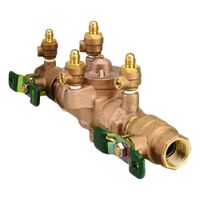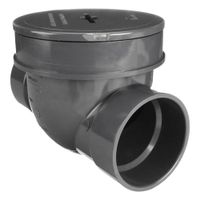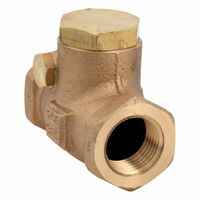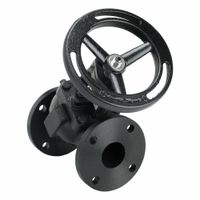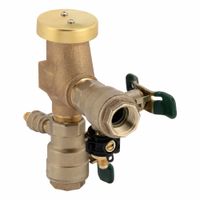Call +(254) 703 030 000 / 751 483 999 / 721 704 777
- Home
- Plumbing
- Plumbing Valves
- Backflow Prevention Valves
Backflow Prevention Valves
Backflow prevention valves ensure fluids move in one direction through a system. Backflow is the reverse flow of media and occurs as back-siphonage or -pressure. Back-siphonage happens during a sudden reduction in pressure or stoppages. Back-pressure occurs when inlet pressure is lower than outlet p .....Read More
Frequently Asked Questions
What is a backflow prevention valve?
A backflow prevention valve is a device designed to prevent the reverse flow of water or other substances into the clean water supply. It is crucial in maintaining the safety and quality of potable water systems by ensuring that contaminants do not enter the water supply through cross-connections. These valves are typically installed in plumbing systems where there is a risk of backflow, which can occur due to changes in pressure that cause water to flow in the opposite direction.
There are several types of backflow prevention valves, including:
1. **Atmospheric Vacuum Breaker (AVB):** This is a simple device that prevents backflow by allowing air to enter the system, breaking the siphon effect that can cause backflow.
2. **Pressure Vacuum Breaker (PVB):** Similar to the AVB, but it can handle higher pressure and is often used in irrigation systems.
3. **Double Check Valve Assembly (DCVA):** This consists of two check valves in series, providing redundancy and ensuring that if one valve fails, the other will still prevent backflow.
4. **Reduced Pressure Zone (RPZ) Valve:** This is the most reliable type of backflow preventer, featuring two check valves and a pressure relief valve. It is used in high-risk situations where the potential for contamination is significant.
Backflow prevention valves are essential in various applications, including residential, commercial, and industrial settings. They are often mandated by plumbing codes and regulations to protect public health. Regular maintenance and testing are necessary to ensure these devices function correctly, as failure can lead to contamination of the water supply, posing health risks to consumers.
How does a backflow prevention valve work?
A backflow prevention valve is designed to ensure that water flows in only one direction, preventing contaminated water from reversing into the clean water supply. It operates through a series of mechanical components that respond to changes in water pressure.
The valve typically consists of a check valve or multiple check valves, which are spring-loaded and open under normal flow conditions. When water flows in the intended direction, the pressure pushes the valve open, allowing water to pass through. If the flow reverses, the pressure on the downstream side decreases, causing the spring to push the valve closed, thus preventing backflow.
Some backflow prevention valves also include an air inlet valve or a relief valve. In the event of back-siphonage, where negative pressure causes water to be drawn backward, the air inlet valve opens to allow air into the system, breaking the siphon effect and stopping the reverse flow.
In more complex systems, such as reduced pressure zone (RPZ) assemblies, the valve includes two check valves with a pressure-regulated relief valve between them. If either check valve fails, the relief valve opens to discharge water, maintaining a lower pressure zone and preventing backflow.
These valves are crucial in protecting potable water supplies from contamination by pollutants, chemicals, or other hazardous substances that could enter through cross-connections in plumbing systems. Regular maintenance and testing are essential to ensure their proper function, as debris or wear can impair their operation.
Why is backflow prevention important?
Backflow prevention is crucial for maintaining the safety and quality of drinking water. Backflow occurs when the normal flow of water is reversed, potentially allowing contaminants to enter the clean water supply. This can happen due to changes in pressure, such as during a water main break or when a fire hydrant is opened, creating a vacuum that draws water back into the system.
The importance of backflow prevention lies in its ability to protect public health. Contaminants that can enter the water supply through backflow include chemicals, bacteria, and other hazardous substances from industrial, commercial, or residential sources. For instance, pesticides from agricultural areas or chemicals from industrial processes can be siphoned back into the potable water system, posing serious health risks.
Backflow prevention devices, such as check valves, air gaps, and reduced pressure zone assemblies, are designed to stop this reverse flow. These devices are installed at strategic points in the water system to ensure that any potential backflow is blocked, maintaining the integrity of the water supply.
Moreover, regulatory compliance is another reason for the importance of backflow prevention. Many regions have stringent regulations and standards that require the installation and maintenance of backflow prevention devices to ensure safe drinking water. Non-compliance can lead to legal penalties and increased liability for water suppliers and property owners.
In summary, backflow prevention is essential for safeguarding public health, ensuring regulatory compliance, and maintaining the integrity of the water supply system. It prevents contamination, protects against health hazards, and ensures that communities have access to safe and clean drinking water.
What are the different types of backflow prevention devices?
There are several types of backflow prevention devices, each designed to prevent the reverse flow of water, which can contaminate clean water supplies:
1. **Air Gap**: This is the simplest and most effective backflow prevention method. It involves a physical separation between the water supply outlet and the flood level of a fixture, ensuring that contaminated water cannot siphon back into the clean water supply.
2. **Atmospheric Vacuum Breaker (AVB)**: This device prevents back-siphonage by introducing air into the system when a negative pressure is detected. It is typically installed on faucets or hose bibs and must be placed downstream of the last control valve.
3. **Pressure Vacuum Breaker (PVB)**: Similar to the AVB, the PVB prevents back-siphonage but can be used under continuous pressure. It includes a check valve and an air inlet valve that opens to break the vacuum if backflow occurs.
4. **Double Check Valve Assembly (DCVA)**: This device consists of two independent check valves in series, providing redundancy. It is suitable for low to medium hazard situations and can handle both back-siphonage and back pressure.
5. **Reduced Pressure Zone Device (RPZ)**: This is the most reliable and versatile backflow preventer, suitable for high-hazard situations. It includes two check valves and a pressure differential relief valve, which discharges water if the pressure between the check valves drops, ensuring no backflow occurs.
6. **Hose Bib Vacuum Breaker**: Specifically designed for hose connections, this device prevents back-siphonage by allowing air to enter the system when a vacuum is detected.
Each type of device is selected based on the level of hazard, the type of backflow (back-siphonage or back pressure), and the specific application requirements.
How do you install a backflow prevention valve?
To install a backflow prevention valve, follow these steps:
1. **Identify Location**: Choose a location on the main water line, typically near the water meter or where the water line enters the building.
2. **Shut Off Water Supply**: Turn off the main water supply to prevent water flow during installation.
3. **Drain the System**: Open faucets to drain any remaining water in the pipes.
4. **Cut the Pipe**: Use a pipe cutter to cut the section of the pipe where the valve will be installed. Ensure the cut is clean and straight.
5. **Prepare the Pipe Ends**: Clean and deburr the pipe ends to ensure a smooth connection.
6. **Install the Valve**: Position the backflow prevention valve between the cut pipe ends. Ensure the valve is oriented correctly, with the flow direction arrow pointing in the direction of water flow.
7. **Connect the Valve**: Use appropriate fittings (e.g., compression, solder, or threaded) to connect the valve to the pipe. Ensure all connections are secure and leak-proof.
8. **Secure the Valve**: If necessary, use brackets or supports to secure the valve in place, preventing movement or stress on the pipe.
9. **Turn On Water Supply**: Slowly turn on the main water supply to check for leaks. Inspect all connections and tighten if necessary.
10. **Test the Valve**: Test the backflow prevention valve to ensure it is functioning correctly. This may involve checking for proper operation and ensuring no backflow occurs.
11. **Inspect Regularly**: Regularly inspect and maintain the valve to ensure continued proper operation and compliance with local regulations.
Always follow local codes and regulations, and consider hiring a professional plumber if unsure about any step.
How often should backflow prevention valves be tested?
Backflow prevention valves should be tested at least annually. This is a general guideline, but the frequency can vary based on local regulations, the type of system, and the specific risk factors associated with the water supply. Some jurisdictions may require more frequent testing, such as semi-annually or quarterly, especially in high-risk areas or for systems that protect public water supplies. It's important to consult local codes and regulations to determine the exact requirements for your area. Regular testing ensures that the valves are functioning properly to prevent contamination of potable water systems.
What are the signs of a failing backflow prevention valve?
Signs of a failing backflow prevention valve include:
1. **Water Leaks**: Unexplained water pooling around the valve or nearby areas can indicate a failure.
2. **Low Water Pressure**: A noticeable drop in water pressure can suggest that the valve is not functioning properly.
3. **Water Flow Reversal**: If water flows in the opposite direction, it indicates the valve is not preventing backflow.
4. **Strange Noises**: Unusual sounds such as banging, gurgling, or vibrating near the valve can signal a malfunction.
5. **Contaminated Water**: Discoloration or unusual taste and odor in the water supply may suggest backflow contamination.
6. **Visible Damage**: Cracks, corrosion, or other physical damage to the valve can impair its function.
7. **Frequent Repairs**: Repeated need for repairs or maintenance can indicate an underlying issue with the valve.
8. **Pressure Relief Valve Activation**: If the pressure relief valve frequently activates, it may be due to backflow issues.
9. **Inconsistent Water Supply**: Fluctuations in water availability or pressure can be a sign of valve failure.
10. **Valve Sticking**: If the valve does not open or close properly, it may be failing.
11. **Unusual Water Bills**: A sudden increase in water bills without a corresponding increase in usage can indicate a leak or backflow issue.
12. **Testing Failure**: Regular testing of the valve that results in failure indicates it is not functioning correctly.
13. **Age of the Valve**: Older valves are more prone to failure due to wear and tear over time.
Regular inspection and maintenance are crucial to ensure the backflow prevention valve functions correctly and to prevent potential water contamination.
